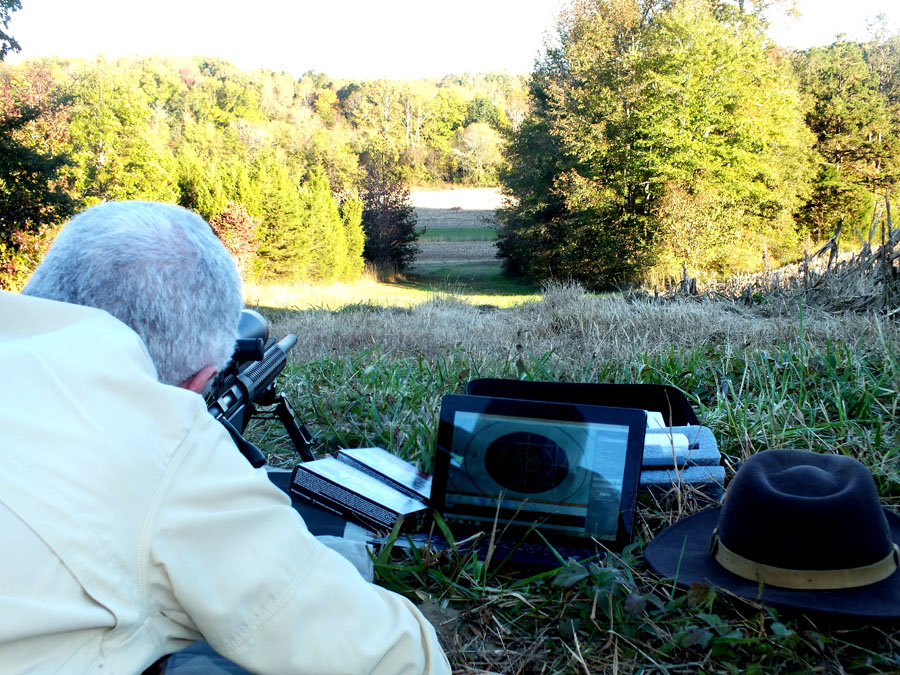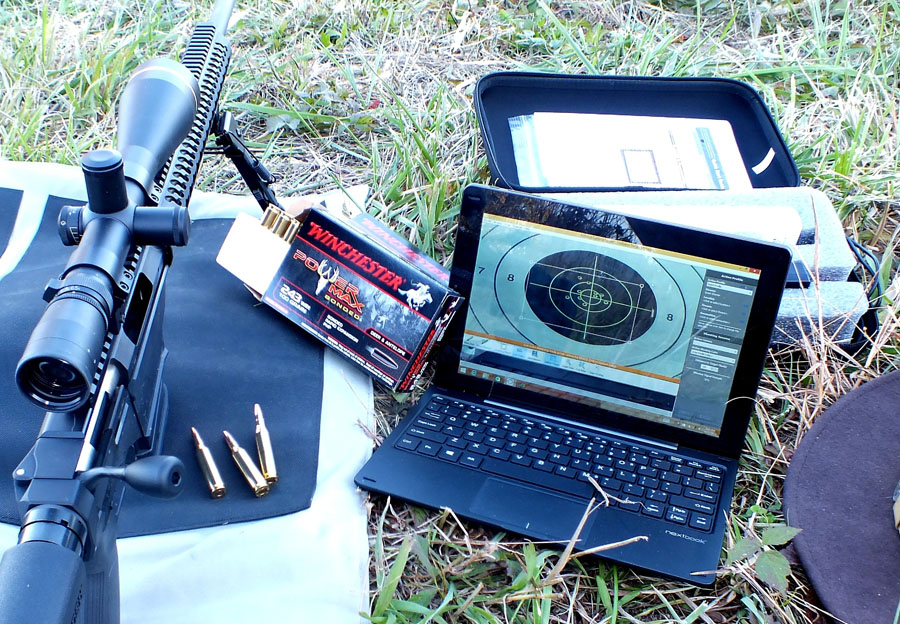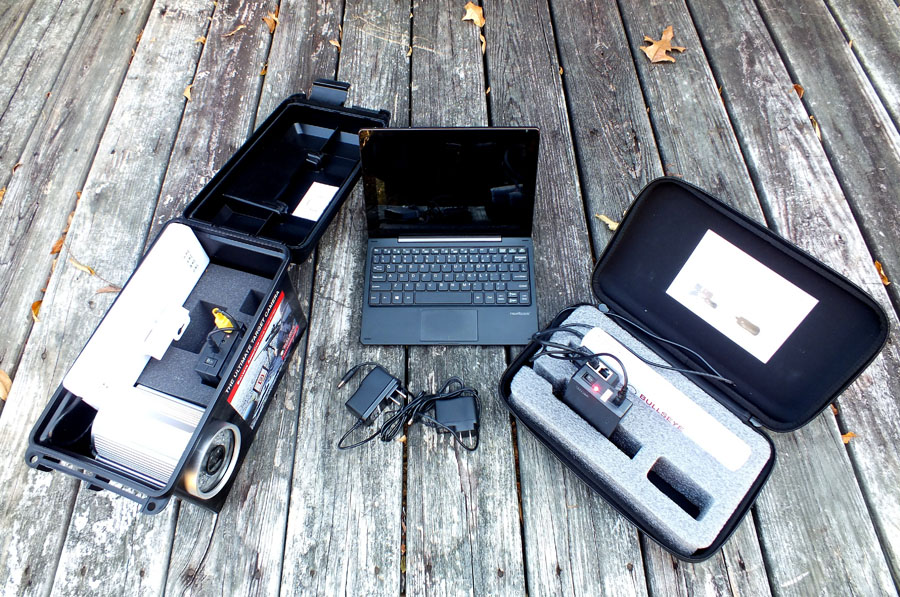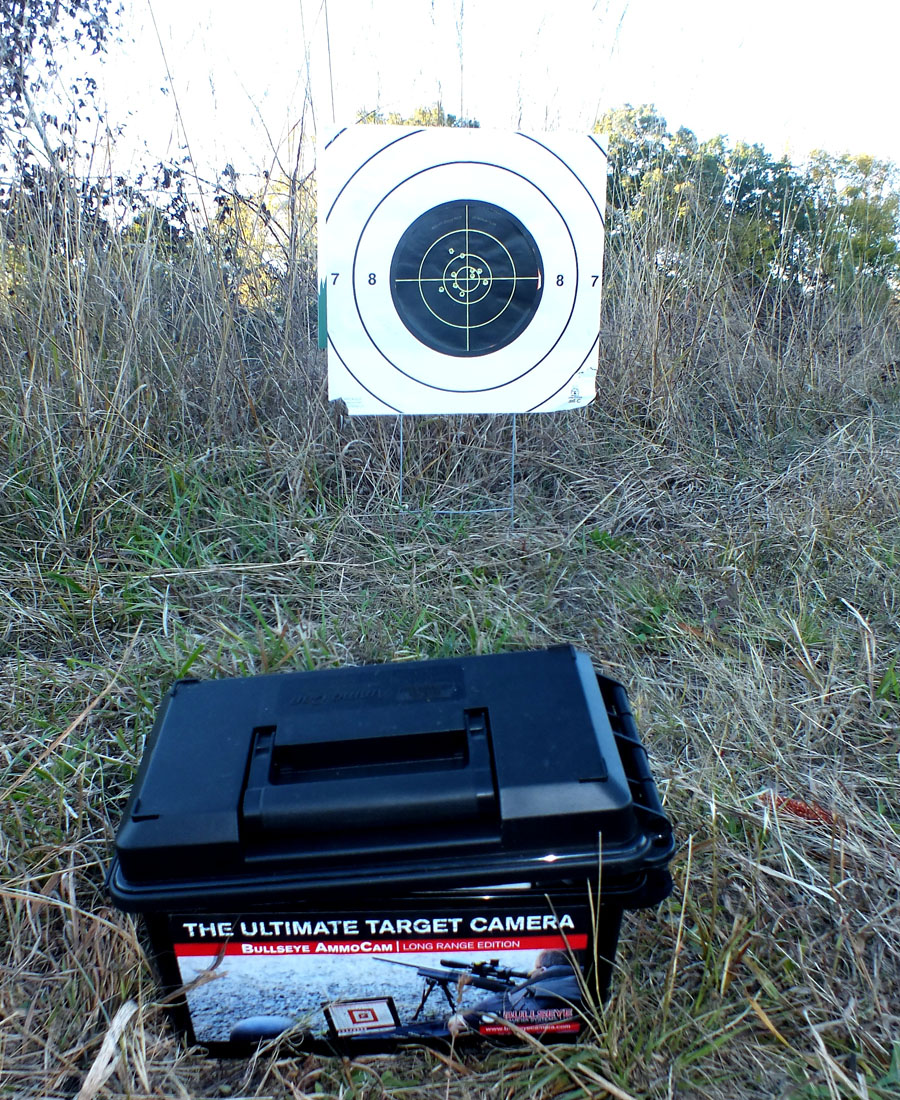[full_width]

My target is 500 yards away and not even visible in the photo. At this distance, a spotting scope is useless if you can’t see dust signature.
[/full_width]
See More at Bullseye: https://www.bullseyecamera.com/
I’m going to get to the actual review of the Bullseye Camera system, but I want to take a moment to explain exactly why this system is so important. For some casual recreational shooters, seeing your target as you shoot can be a novelty. For anyone serious about long range shooting, it is invaluable.
Let’s go back a bit…. I was shooting an M14 match rifle for the first time in a match. I’d shot two NRA High Power matches at that time, but both had been with a standard M1 rifle, and my scores had been dismal. I’d gotten the High Power bug, and now I was competing with my own Hawkeye rifleman’s coat, a brand new mat, stool, spotting scope and a DCM State Team M14 rifle. It was my first real attempt at serious High Power competition. It was also the North Carolina State Championship.
My offhand score had been great, winning Marksman class for that stage. I’d done OK at sitting and prone rapid fire, but I was intimidated about shooting back to back 20 shot, 600 yard slow fire strings. Other than what I’d read in a primer for High Power shooters put out by the U.S. Army Marksmanship Training Unit, I knew nothing about reading the wind.
I watched the two guys on the preceding relays and listened to what they were saying about the wind before the shooting started. In NRA High Power, the scorekeeper and shooter can’t discuss wind strategy during firing time, once you lie down to shoot, you’re on your own. I struggled through it, mostly by chasing my spotter, but managed a reasonable score for a Marksman. It was May of 1984. I know that because the trophy for first Marksman, my first ever award in High Power, is on the shelf above my desk. I managed to win the Marksman class in my first ever real match with a real rifle.
Eventually, through years of shooting, I managed to learn to read wind quite well. I earned the Distinguished Rifleman badge, coached and captained teams at Camp Perry, and won two regional 1,000 yard Service Rifle Championships.
Learning to read wind well enough to keep your shots on target is a tough proposition. It requires constant vigilance and a good deal of intuition. Wind flags are valuable, but the most reliable method I found was by reading mirage, the refraction of light waves by heat. By reading the direction, amplitude, and frequency of mirage, it’s possible to put your first shot from an iron sighted 7.62mm M14 into a 20 inch ten ring at 1,000 yards with considerable regularity.
The most productive education I had was in coaching good shooters who were consistently capable of shooting tens. If you’re the coach and a good shooter’s shot is on the right side of the target, you know you missed the wind, therefore you learn instantly from your error. As a coach, you’re watching the wind as the shooter fires the shot. You know the shooter is capable of shooting an X, and a shot on the right side of the ten means you missed the wind. You can instantly critique yourself because you have instant feedback as soon as the marked target comes out of the pits.
Until recently, I simply couldn’t imagine any other reliable method of learning to read wind. Consistently seeing bullet holes beyond 300 yards is almost impossible, even with the large .30 caliber holes we used to make. Let the mirage crank up in the heat of the day and bullet holes at 200 yards are tough. Shooting a target and then riding down to check results does little good because it’s rare to shoot as many as five shots in a consistent wind, unless you’re shooting really fast. As a shooter and coach, I rarely went through five shots without making a windage correction.
Unfortunately, most of us don’t have unlimited access to a known distance range with pits to allow instant marking and evaluation of a target. Even if we do, most K.D. ranges only have firing lines at 200, 300, 600, and 1,000 yards. Also, remember someone has to be in the pits to pull and mark your target.
[full_width]

The camera tracks hits and will flash before/after images so you can be sure which is the most recent hit.
[/full_width]
See your shots, live, in real time
This admittedly long prelude is exactly why I was so excited the first time I saw the Bullseye Target Camera system. Consisting of a video camera, a transmitter, a receiver and a Wi-Fi modem, The Bullseye system gives the shooter instant feedback of his last shot at distances of up to one mile. A live image of the target is displayed on a tablet, computer or phone screen. You shoot, you check the location of the shot instantly, and provided you shoot well and have an accurate rifle, you instantly know the effects of the wind you just observed.
Operation is remarkably simple, even for a curmudgeon like me. After charging and installing the software into the device you plan to view from, you turn on both the camera/transmitter and receiver/modem. Select the Bullseye camera icon and the device will find the Wi-Fi signal. Using the device screen, arrange the camera for the best view of the target. There are two different viewing magnifications. It’s easier to set the camera if you use the wider angle, but safer for the camera to spend a bit more time getting the angle right for use in the telephoto setting.
Once this is done, you can travel back to your shooting position (as much as a mile away). Set the screen to shooting mode which will bring up a red bar above the toolbar. In shooting position, you can tap the space bar after every shot and the screen will switch from the previous screen to the current screen, which will make your last shot appear to flash. You can also shoot a three or five shot group before resetting to allow the most recent group to flash.
[full_width]

The complete system for the Long Range AmmoCam is in two cases, the camera unit with tripod and charger and the receiver/Wi-Fi unit with its charger. I used a low cost Nextbook Pad to monitor the target.
[/full_width]
I tested the Bullseye AmmoCam in two different situations. First, I set it up at the open house of my local gun club to sight in rifles for the upcoming deer season. Every time I used it to sight in a gun, the system drew a crowd of interested onlookers. Next, I used it to get long range zeros on a Ruger Precision Rifle for an Alabama hog hunt. I was going to hunt a power line with long range shooting opportunities and I needed to get a solid idea of adjustments I’d need for the longer shots. Behind my little farm, there’s a meadow that spans a bit over 500 yards, so I set up there. Once past 300 yards, even the best spotting scope is an iffy proposition, but the AmmoCam allowed me, not only to get zeros at 400 and 500 yards but allowed for easy load testing as well. There’s simply no other method of testing that’s this easy or effective. For the long range hunter or shooter, it’s a godsend.
Depending on what you’re trying to accomplish, the Bullseye Camera system might eliminate the need for a spotting scope. For spotting shots, it’s far superior to a spotting scope because it’s unaffected by distance or mirage. For learning to read wind and manage wind corrections, use your spotting scope to read mirage, fire an accurate shot, and learn from the deflection. The instant feedback from the Bullseye camera will allow you to know instantly if your call was correct and whether you over or under doped the wind. The learning curve will sharpen exponentially because you won’t be limited by the constraints of shooting on a K.D. range and needing a puller to mark every shot as it’s fired. If you should pair up with another shooter, with one acting as shooter and the other as coach, you’ll learn even faster. With one person on the rifle and one on the scope, the exact wind at the time of the shot is noted, eliminating surprise changes that come from the time your eye leaves the spotting scope to the time the shot is fired.
[full_width]

The AmmoCam is set at a reasonable distance from the target and is aligned with a supplied tripod support that fits into the weatherproof case.
[/full_width]
Bullseye offers several different levels of systems with the 300 yard Sight-in edition priced at $349.00 and the top of the line Long Range Elite system priced at $949.00. It comes complete with an Acer Aspire One laptop. I tested the Long Range AmmoCam version. It comes with the camera and transmitter housed in a weather proof plastic box with the receiver in a separate case. Both units have their own charging systems and the camera has an adjustable tripod for adjusting the camera angle. Had I had something like this when I was shooting in the ‘80s and ‘90s, I’d have learned a lot faster and might have a few more medals in my case.
This is a great camera system and I have had a ball with it. If you are thinking of getting one of these you will love just what is will do. You can’t go wrong with it when you are shooting out there at 200 + yards. This even makes it good for sighting in your rifles to.
Hi,
Thanks for the article. I had never heard of this system before. I definitely need to look into it some more and maybe even review it myself.
So, it is a basic house security camera hooked up to a wireless transmitter, and it takes screen shots after each shot?
How well does it track shots that go into one of the previously made holes (especially when the hole is a bigger hole made by several shots)?
I have this and it will show you where you shoot even if it goes in the same hole every time. You will not go wrong by getting this. I love it.
How well does it track shots that go into one of the previously made holes (especially when the hole is a bigger hole made by several shots)?
Excellent system. Top notch factory service on it if you have a problem. Bought the 300 yard system and it works fine at 400 yards. I think if you used long distance wi-fi receiver on your notebook computer this system would go much further out. Camera could have better resolution but you can see shots good enough.
The ATN X-Sight does so much more and is self-contained.You should consider doing a review on that piece of magic. Admittedly , there were a couple of problems with the X-sight when first released , but those issues have been addressed and fixed.Along with software updates and a great group of users on the net for discussions and help with mastering the small bump of a learning curve. The one feature that really got me interested was the ONE SHOT ZERO , AMAZING!!!!! Oh , yes it has a few features more than needed , but at the price they go for it’s like getting GPS wi-fi night vision with included illumination and a digital recording device built in for free……
The ATN scope is all well and good but how do you use an iron sighted rifle like in NRA Highpower with it? You don’t unless you’re suggesting you can use the X-Sight as a video camera to zoom in on the target? Hardly as effective. I don’t have either a Bullseye system or an X-Sight but I can certainly see the usefulness of both.
I think for someone like me out here in the wide open southwest, I can set up my target stand then keep driving further and further away without moving the target because I predominately shoot steel. 400m would be my limit for my coyote rifle but I’d want to move a lot further back with my .300 Win Mag and .338 Lapua. With this, I just need to move the truck and not the target.
Thanks for the review but a little more detail would have been helpful such as if you can easily save the results of your shooting trip for further review or edit the results afterwards or what file type the system uses. I would also have liked to have seen some steel shots and how far the camera could be placed away from the target to avoid splash from the target taking out the camera. All in all, it was pretty good and nice to hear from an accomplished shooter rather than a millennial with not much idea…..
I have had one of these for awhile and am very impressed with it. Wish they offered a little better quality camera with an inexpensive zoom lens, but the package is quite nice as is. One significant advantage is that you can track lots of shots without losing track of which is which after 5 shots or so – a feature I especially like.
It is a nice idea, but at their price point you could accomplish the same task with a drone and your cell phone, and then you would still have a drone to play with when you are not shooting. BOBW (best of both worlds) baby.
Plus when your done you can just fly it back to You without the 3-5-900 yard walks. And, its the best reason to buy one of those things I have heard of yet! 😉
As soon as I saw this I thought “why didn’t I think of this”. Seems so obvious. With a little software voodoo, I imagine this system could do quite a lot, like animated shot placement, integration with wind/temp conditions.